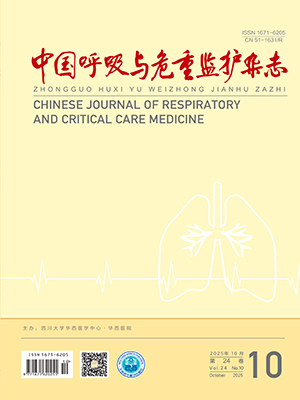| 1. |
Peres BU, Allen AJH, Shah A, et al. Obstructive sleep apnea and circulating biomarkers of oxidative stress: a cross-sectional study. Antioxidants (Basel), 2020, 9(6): 476.
|
| 2. |
Yu LM, Zhang WH, Han XX, et al. Hypoxia-induced ROS contribute to myoblast pyroptosis during obstructive sleep apnea via the NF- κ B/HIF-1 α signaling pathway. Oxid Med Cell Longev, 2019, 11(2019): 4596368.
|
| 3. |
Maniaci A, Iannella G, CocuzzaS, et al. Oxidative stress and inflammation biomarker expression in obstructive sleep apnea patients. J Clin Med, 2021, 10(2): 277.
|
| 4. |
Chen YL, Weng SF, Shen YC, et al. Obstructive sleep apnea and risk of osteoporosis: a population-based cohort study in Taiwan. J Clin Endocrinol Metab, 2014, 99(7): 2441-2447.
|
| 5. |
Yen CM, Kuo CL, Lin MC, et al. Sleep disorders increase the risk of osteoporosis: a nationwide population-based cohort study. Sleep Med, 2014, 15(11): 1339-1344.
|
| 6. |
中华医学会呼吸病学分会睡眠障碍学组. 阻塞性睡眠呼吸暂停低通气综合征诊治指南(2011年修订版). 中华结核和呼吸杂志, 2012, 35(1): 9-12.
|
| 7. |
Pazarli AC, Ekiz T, İnönü Köseoğlu H. Association between 25-hydroxyvitamin D and bone mineral density in people with obstructive sleep apnea syndrome. J Clin Densitom, 2019, 22(1): 39-46.
|
| 8. |
Qiao Y, Wang B, Yang JJ, et al. Bone metabolic markers in patients with obstructive sleep apnea syndrome. Chin Med J (Engl), 2018, 131(16): 1898-1903.
|
| 9. |
Ugay L, Kochetkova E, NevzorovaV, et al. Role of osteoprotegerin and receptor activator of nuclear factor-κB ligand in bone loss related to advanced chronic obstructive pulmonary disease. Chin Med J (Engl), 2016, 129(14): 1696-1703.
|
| 10. |
Chakhtoura M, Nasrallah M, Chami H, et al. Bone loss in obesity and obstructive sleep apnea: a review of literature. J Clin Sleep Med, 2015, 11(5): 575-580.
|
| 11. |
Terzi R, Yılmaz Z. Bone metabolism parameters and inactive matrix Gla protein in patients with obstructive sleep apnea. J Bone Miner Metab, 2016, 34(4): 475-481.
|
| 12. |
Liu MM, Li Y, Yang ST. Effects of naringin on the proliferation and osteogenic differentiation of human amniotic fluid-derived stem cells. J Tissue Eng Regen Med, 2017, 11(1): 276-284.
|
| 13. |
Zhou QZ, Zhu L, Zhang DF, et al. Oxidative stress-related biomarkers in postmenopausal osteoporosis: a systematic review and meta-analyses. Dis Markers, 2016, 2016: 7067984.
|
| 14. |
Agidigbi TS, Kim C. Reactive oxygen species in osteoclast differentiation and possible pharmaceutical targets of ROS-mediated osteoclast diseases. Int J Mol Sci, 2019, 20(14): 3576.
|
| 15. |
Almeida M, Han L, Martin-Millan M, et al. Skeletal involution by age-associated oxidative stress and its acceleration by loss of sex steroids. J Biol Chem, 2007, 282(37): 27285-27297.
|
| 16. |
Baek KH, Oh KW, Lee WY, et al. Association of oxidative stress with postmenopausal osteoporosis and the effects of hydrogen peroxide on osteoclast formation in human bone marrow cell cultures. Calcif Tissue Int, 2010, 87(3): 226-235.
|
| 17. |
Xu NR, Liu H, Qu F, et al. Hypoxia inhibits the differentiation of mesenchymal stem cells into osteoblasts by activation of Notch signaling. Exp Mol Pathol, 2013, 94(1): 33-39.
|
| 18. |
Gurban CV, Balaş MO, Vlad MM, et al. Bone turnover markers in postmenopausal osteoporosis and their correlation with bone mineral density and menopause duration. Rom J Morphol Embryol, 2019, 60(4): 1127-1135.
|
| 19. |
Mederle OA, Balas M, Ioanoviciu SD, et al. Correlations between bone turnover markers, serum magnesium and bone mass density in postmenopausal osteoporosis. Clin Interv Aging, 2018, 13: 1383-1389.
|
| 20. |
Ma XR, Wang Y, Sun YC. Imbalance of osteoprotegerin/receptor activator of nuclear factor-κB ligand and oxidative stress in patients with obstructive sleep apnea-hypopnea syndrome. Chin Med J (Engl), 2019, 132(1): 25-29.
|




